
South Kalimantan is a province of Indonesia. It is the second most populous province on the island of Kalimantan, the Indonesian territory of the island of Borneo after West Kalimantan. The provincial capital was Banjarmasin until 15 February 2022 when it was legally moved 35 kms southeast to Banjarbaru. The population of South Kalimantan was recorded at just over 3.625 million people at the 2010 Census, and at 4.07 million at the 2020 Census. The official estimate as at mid 2023 was 4,221,929. One of the five Indonesian provinces in Kalimantan, it is bordered by the Makassar Strait in the east, Central Kalimantan in the west and north, the Java Sea in the south, and East Kalimantan in the northeast. The province also includes the island of Pulau Laut, located off the eastern coast of Kalimantan, as well as other smaller offshore islands. The province is divided into 11 regencies and 2 cities. South Kalimantan is the traditional homeland of the Banjar people, although some parts of East Kalimantan and Central Kalimantan are also included in this criterion. Nevertheless, South Kalimantan, especially the former capital city Banjarmasin has always been the cultural capital of Banjarese culture. Many Banjarese have migrated to other parts of Indonesia, as well as neighbouring countries such as Singapore and Malaysia. In addition, other ethnic groups also inhabit the province, such as several groups of the Dayaks, who mostly live in the interior part of the province, as well as the Javanese, who mostly migrated from Java due to the Transmigration program which dated from the Dutch colonial era. It is one of the provinces in Indonesia that has a larger population than Mongolia.
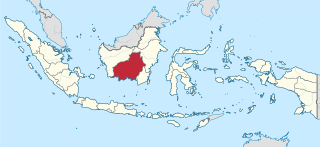
Central Kalimantan is a province of Indonesia. It is one of five provinces in Kalimantan, the Indonesian part of Borneo. It is bordered by West Kalimantan to the west, South Kalimantan and East Kalimantan to the east, Java Sea to the south and is separated narrowly from North Kalimantan and Malaysia by East Kalimantan's Mahakam Ulu Regency. Its provincial capital is Palangka Raya and in 2010 its population was over 2.2 million, while the 2020 Census showed a total of almost 2.67 million; the official estimate as at mid 2023 was 2,774,747, and was projected to rise to 2,809,700 at mid 2024.

Banjarmasin is the largest city in South Kalimantan, Indonesia. It was the capital of the province until 15 February 2022. The city is located on a delta island near the junction of the Barito and Martapura rivers. Historically the centre of the Banjarese culture, and the capital of the Sultanate of Banjar, it is the biggest city in South Kalimantan and one of the main cities of Kalimantan. The city covers an area of 98.46 km2 (38.02 sq mi) and had a population of 625,481 as of the 2010 Census and 657,663 as of the 2020 Census; the official estimate as of mid 2023 was 675,915. It is the third most populous city on the island of Borneo.

The Banjar or Banjarese are an Austronesian ethnic group native to the Banjar regions in the southeastern Kalimantan regions of Indonesia. Nowadays, Banjarese diaspora can be found in neighbouring Banjar regions as well; including Kotabaru Regency, the southeastern regions of Central Kalimantan, southernmost regions of East Kalimantan, and some provinces of Indonesia in general. The Banjarese diaspora community also can be found in neighbouring countries of Indonesia, such as Brunei, Malaysia, and Singapore.

Ma'anyan, Dayak Maanyan or Eastern Barito Dayak people are an ethnic group of the Dayak people indigenous to Borneo. They are also considered as part of the east Barito Dusun group with the name Dusun Ma'anyan. According to J. Mallinckrodt (1927), the Dusun people group is part of the Ot Danum people cluster, although later that theory was disproved by A. B. Hudson (1967), who argues that the Ma'anyan people are a branch of the Barito family. The Ma'anyan people who are often referred to as Dayak people are also referred to as Dayak Ma'anyan. The Dayak Ma'anyan people inhabit the east side of Central Kalimantan, especially in the East Barito Regency and parts of South Barito Regency which are grouped as Ma'anyan I. The Dayak Ma'anyan people also inhabit the northern parts of South Kalimantan, especially in Tabalong Regency which refers to the Dayak Warukin people. The Dayak Balangan people or Dusun Balangan people which are found in the Balangan Regency and the Dayak Samihim people that are found in the Kotabaru Regency are grouped together with the Dayak Ma'anyan people group. The Dayak Ma'anyan people in South Kalimantan are grouped as Ma'anyan II.
Lawangan or Luangan people are an ethnic group of the Dayak Dusun people group, sometimes also referred to as Dusun Lawangan or Dayak Lawangan. The Lawangan people inhabit the eastern side of Central Kalimantan and West Kutai Regency, East Kalimantan, Indonesia. In Tabalong Regency, South Kalimantan, the Lawangan people can be found only in Binjai village. They speak Lawangan language.
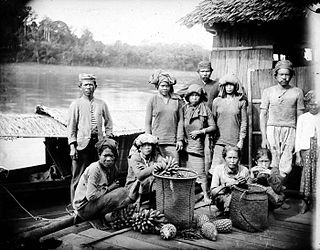
Bakumpai or Baraki are indigenous people of Borneo and are considered as a sub-ethnic group of the Dayak Ngaju people group with Islamic background. The Bakumpai people first occupy along the Barito riverbanks in South Kalimantan and Central Kalimantan, from Marabahan to Puruk Cahu, Murung Raya Regency. The Bakumpai people first appeared as a newly recognized people group in census 2000 and were made up of 7.51% of Central Kalimantan population, which before this the Bakumpai people were considered as part of the Dayak people in a 1930 census.

Sunan Giri Mosque is located near Gresik, about 45 kilometres from Surabaya, Indonesia. Its pavilion shelters the tomb of Sunan Giri, one of the nine Muslim saints of Java, and like the tombs of the other wali sanga, it is a significant and highly auspicious pilgrimage point. This site is often referred to as Giri Kedaton.

Tanjung, or also commonly known as Tanjung Tabalong, is a town and district, which forms the administrative centre of Tabalong Regency in the Indonesian province of South Kalimantan.
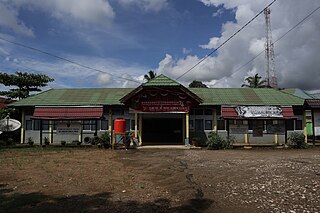
Banua Lawas is a district in Tabalong Regency, South Kalimantan Province, Indonesia. The majority of population in this district is Banjar people whose belief is Islam.
The Darrusalam Great Mosque is the second largest mosque in the province of East Kalimantan after the Samarinda Islamic Center Mosque, and it is located in Pasar Pagi, Samarinda Ilir, Samarinda, which is the center of Samarinda city. The main characteristics of the mosque is that it has a large green dome and several small domes adjacent to the dome and has four minarets. The mosque is facing Mahakam River.

Rao Rao Mosque is one of the oldest mosques in Indonesia located in Nagari Rao Rao, Tarab River, Tanah Datar Regency, West Sumatra. It is located on the road from Batusangkar bound to Bukittinggi, precisely in Rao Rao. This mosque of Minangkabau and Persian architecture was built in 1908 with a roof made from fibers before being changed to zinc.
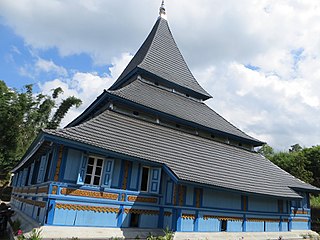
The Bingkudu Mosque is one of the oldest mosques in Indonesia. It was founded by the Padri in the wake of the Padri War in West Sumatra in 1823. This mosque with typical Minangkabau style architecture is located in Jorong Bingkudu, Nagari Canduang Koto Laweh, Canduang District, Agam Regency, West Sumatra. When it was first built, the building of the mosque was made of wood on its floor, pole, and wall.

Koto Baru Grand Mosque is one of the oldest mosques in Indonesia located in Koto Baru Nagari, Sungai Pagu District, South Solok Regency, West Sumatra.

Kampong Junjongan also Kampong Junjungan or simply Junjongan, is a village in the south-east of Brunei–Muara District, Brunei, about 16 kilometres (9.9 mi) from the capital of Brunei, Bandar Seri Begawan. According to 2016 records, the population was 2,006. It is one of the villages within Mukim Pengkalan Batu. The postcode is BH2123.
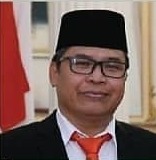
Alue Dohong is an Indonesian politician. He was Deputy Minister of Environment and Forestry from 2019 to 2024. Before appointed as deputy minister, he was a lecturer in University of Palangka Raya. Other than that, he also worked on Peat Land Restoration Agency. He is the first of ethnic Dayak origin that in Deputy Minister in Indonesia. Born in East Kotawaringin Regency, he got bachelor on economy in University of Palangka Raya and continuing to University of Nottingham to get Master of Science and doctor in University of Queensland.

Al-Istiqlal Great Mosque, Murung Raya is the largest mosque in the entire Murung Raya Regency, Central Kalimantan, Indonesia. This great mosque is located on Jendral Sudirman Street, in the district of Murung, Murung Raya Regency. This great mosque is one of the most popular icons of Murung Raya Regency.
Negara Dipa was a Hindu kingdom in South Kalimantan that appears in Hikayat Banjar. It was located in Amuntai near modern-day Tabasan. It was also the predecessor of Negara Daha and Banjar Sultanate.



















